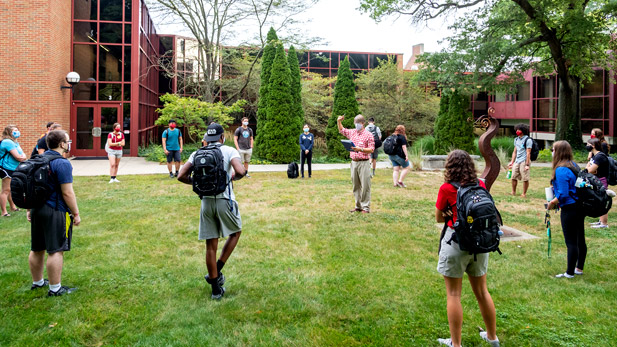New Course on Past Epidemics Provides Lessons to Students Adapting to COVID-19 World

History professor Sam Martland's new Epidemics and the Development of Public Health course, taught in fall 2020, gave students valuable insights into past global pandemics and public health measures.
Lessons from past global public health crises have helped a group of Rose-Hulman students better understand and appreciate the challenges in developing reasonably effective responses to new and future diseases, such as COVID-19, through a new history course.
Taught for the first time during the fall academic quarter, history professor Sam Martland’s Epidemics and the Development of Public Health course explored the relationship between society and infectious disease. In particular, students studied coordinated public health efforts from seven past epidemics to protect and treat populations. Then, they learned how to use their skills as future scientists, engineers and mathematicians to solve similar problems facing humanity.
A CollegeSource analysis of course catalog data from nearly 7,200 colleges and universities reveals that no more than 40 U.S. higher education institutions offered 51 summer or fall 2020 courses on COVID, pandemic or coronavirus issues.
“It’s important to understand different people’s needs, fears and priorities,” said Martland, who has taught a complimentary Disasters and Modern Society course at Rose-Hulman for several years. “Students could see uncertainty and disagreement from the past six centuries and compare them to the uncertainty and disagreement that was playing out every day in the news. I didn’t talk much about COVID-19 and tried very hard not to get into current politics, but students made the connections often.”
Instead, Martland developed coursework that examined public health measures regarding such diseases as Black Death, smallpox, polio, Spanish influenza, cholera, and HIV/AIDS. There were lively classroom discussions and readings of publications about those past pandemics. Finally, each student gathered real information about scientific and social aspects of a complex problem for a research paper that explained information to a non-specialized audience.
“I’ve always enjoyed history and the possibility of learning history through the lens of public health/disease piqued my interests. I thought it would make a good learning opportunity,” said Sophia Koop, a first-year biomedical engineering major from Lawrenceville, Georgia. “The class gave me some insight on how pandemics affected society and how to better deal with COVID-19 now. Many pandemics of the past inspired fear in the individuals of society, causing irrational responses and a fear of the people around them.”
She related that the past and current public health crises have been catalysts for scientific discovery, such as improved vaccination production or development and sophistication within medical fields across the globe.
“Looking at COVID-19 today in the context of past pandemics, I think it is best to follow the evidence we’ve been given by the scientific community … It shows us that it is best to not live in fear of this disease. We can take the proper precautions, while also still living our lives well,” Koop added.
Eighteen first-year students were among the 38 enrollees across two course sections this fall. They brought their own perspectives to classroom discussions as teenagers whose final year of high school was disrupted by COVID-19 health and safety precautions.
“I experienced the delay of my (high school) prom and graduation, and the cancellation of many other important events,” stated Karmen Kissell, a first-year biomedical engineering student from Shelbyville, Indiana. “Starting college during these strange times has also caused its share of difficulties. Nearly every event has moved online or been changed in some way to protect everyone. This class made me realize how much damage a pandemic can cause in every aspect of society. The course also has proved that we should support science because it is what will help us to get through this.”
For a final research project, first-year software engineering student Jenna Strassburger explored the causes and effects of cholera epidemics on Cincinnati, her hometown. The city of Mount Healthy within the southwestern Ohio region was founded as a haven for those who were not infected with cholera during the outbreaks.
“I grew up learning about and visiting this town for school, so I was excited to have the opportunity to further explore the subject,” she said. “I could recognize places and events that occurred in my hometown ... As we deal with the COVID-19 pandemic, we can learn from these pitfalls by remaining hopeful. We must continue to do what is best for the health of society while keeping our eyes set on a future without coronavirus.”
Other students researched such topics as “How Crippling Fear Caused America to Wage a War on Polio,” “HIV/AIDS in the U.S. and How Community Influenced Policy,” and “The Effect of World War I on Spanish Influenza.”
For seniors Lindsey Alumbaugh, Katie Goebel, and Zeyu Liao the course aligned with their personal interests in medicine, medical research, and biomedical engineering.
“I was interested in learning more about how our understanding of the spread of disease has evolved over time. I also wanted to learn more about the different methods that physicians and public officials have used to control the spread of epidemics and pandemics in the past,” said Goebel, a biomedical engineering student from Fairland, Indiana.
Alumbaugh added, “I learned a lot about how exactly different diseases shaped our history.”